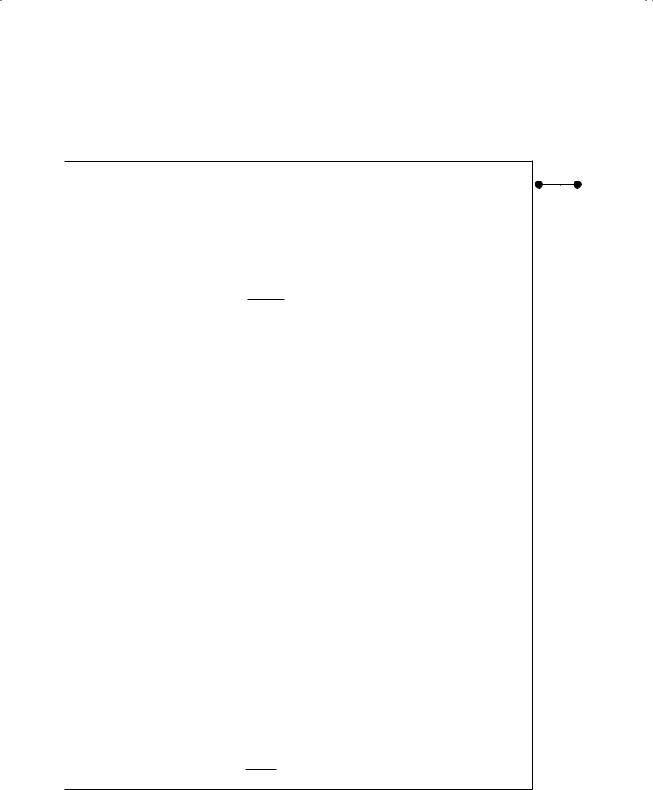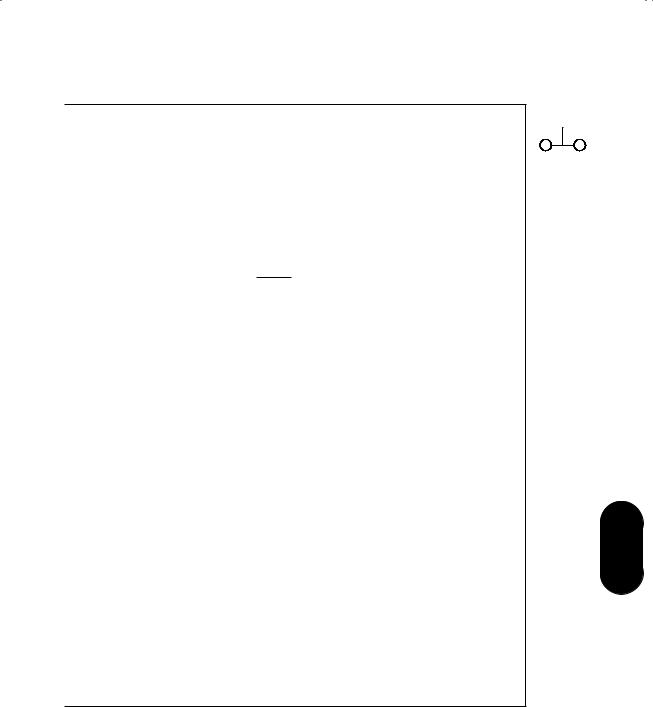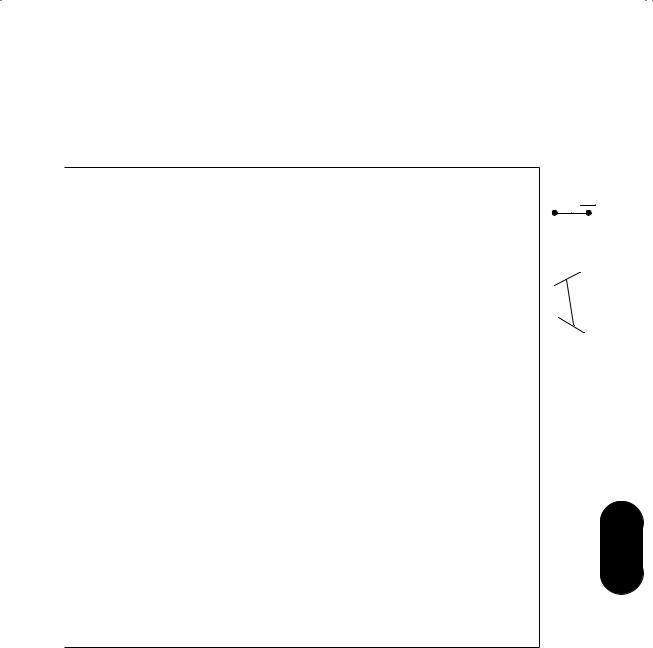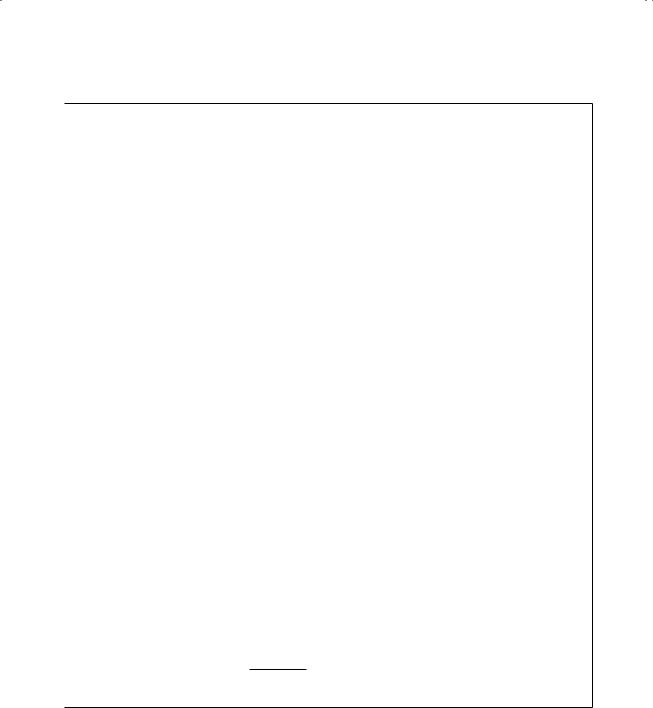
- •Contents
- •Preface
- •How to use this book
- •Chapter 1 Units, constants, and conversions
- •1.1 Introduction
- •1.2 SI units
- •1.3 Physical constants
- •1.4 Converting between units
- •1.5 Dimensions
- •1.6 Miscellaneous
- •Chapter 2 Mathematics
- •2.1 Notation
- •2.2 Vectors and matrices
- •2.3 Series, summations, and progressions
- •2.5 Trigonometric and hyperbolic formulas
- •2.6 Mensuration
- •2.8 Integration
- •2.9 Special functions and polynomials
- •2.12 Laplace transforms
- •2.13 Probability and statistics
- •2.14 Numerical methods
- •Chapter 3 Dynamics and mechanics
- •3.1 Introduction
- •3.3 Gravitation
- •3.5 Rigid body dynamics
- •3.7 Generalised dynamics
- •3.8 Elasticity
- •Chapter 4 Quantum physics
- •4.1 Introduction
- •4.3 Wave mechanics
- •4.4 Hydrogenic atoms
- •4.5 Angular momentum
- •4.6 Perturbation theory
- •4.7 High energy and nuclear physics
- •Chapter 5 Thermodynamics
- •5.1 Introduction
- •5.2 Classical thermodynamics
- •5.3 Gas laws
- •5.5 Statistical thermodynamics
- •5.7 Radiation processes
- •Chapter 6 Solid state physics
- •6.1 Introduction
- •6.2 Periodic table
- •6.4 Lattice dynamics
- •6.5 Electrons in solids
- •Chapter 7 Electromagnetism
- •7.1 Introduction
- •7.4 Fields associated with media
- •7.5 Force, torque, and energy
- •7.6 LCR circuits
- •7.7 Transmission lines and waveguides
- •7.8 Waves in and out of media
- •7.9 Plasma physics
- •Chapter 8 Optics
- •8.1 Introduction
- •8.5 Geometrical optics
- •8.6 Polarisation
- •8.7 Coherence (scalar theory)
- •8.8 Line radiation
- •Chapter 9 Astrophysics
- •9.1 Introduction
- •9.3 Coordinate transformations (astronomical)
- •9.4 Observational astrophysics
- •9.5 Stellar evolution
- •9.6 Cosmology
- •Index

142 |
Electromagnetism |
|
|
7.4 Fields associated with media
Polarisation
Definition of electric |
p = qa |
|
|
|
|
|
(7.80) |
||||
dipole moment |
|
|
|
|
|
||||||
|
|
|
|
|
|
|
|
|
|||
|
|
|
|
|
|
|
|
|
|
||
Generalised electric |
p = |
r |
|
ρ dτ |
(7.81) |
||||||
|
|
|
|||||||||
dipole moment |
|
volume |
|
|
|
|
|||||
Electric dipole |
φ(r) = |
|
|
p · r |
(7.82) |
||||||
|
|
|
|
||||||||
potential |
|
|
|
4π 0r3 |
|
||||||
|
|
|
|
|
|
|
|
|
|
||
Dipole moment per |
|
|
|
|
|
|
|
|
|
||
unit volume |
P = np |
|
|
|
|
(7.83) |
|||||
(polarisation)a |
|
|
|
|
|
|
|
|
|
||
Induced volume |
· P = −ρind |
(7.84) |
|||||||||
charge density |
|||||||||||
|
|
|
|
|
|
|
|
|
|
||
Induced surface |
σind = P · sˆ |
|
|
(7.85) |
|||||||
charge density |
|
|
|||||||||
|
|
|
|
|
|
|
|
|
|
||
Definition of electric |
D = 0E + P |
(7.86) |
|||||||||
displacement |
|||||||||||
|
|
|
|
|
|
|
|
|
|||
|
|
|
|
|
|
|
|
|
|
||
Definition of electric |
P = 0χE E |
|
|
(7.87) |
|||||||
susceptibility |
|
|
|||||||||
|
|
|
|
|
|
|
|
|
|||
|
|
|
|
|
|
|
|
|
|
||
Definition of relative |
r = 1 + χE |
|
|
(7.88) |
|||||||
D = 0 rE |
|
|
(7.89) |
||||||||
permittivityb |
|
|
|||||||||
|
= E |
|
|
|
|
(7.90) |
|||||
|
|
|
|
|
|
|
|||||
|
|
|
|
|
|
|
|
|
|
|
|
Atomic |
|
p = αE loc |
|
|
(7.91) |
||||||
polarisabilityc |
|
|
|||||||||
|
|
|
|
|
|
|
|
|
|||
Depolarising fields |
|
|
|
|
NdP |
|
|||||
|
|
|
|
|
|
|
|
|
|||
E d = − 0 |
|
|
(7.92) |
||||||||
|
|
|
|
||||||||
|
|
|
|
|
|
|
|
|
|
||
Clausius–Mossotti |
|
nα |
|
r − |
1 |
|
(7.93) |
||||
equation |
d |
|
|
= |
|
|
|
||||
3 0 |
|
|
|
||||||||
|
|
r + 2 |
|
||||||||
±q end charges
acharge separation vector (from − to +)
pdipole moment
ρcharge density
dτ |
volume element |
r |
vector to dτ |
φdipole potential
rvector from dipole
0 |
permittivity of free |
|
space |
Ppolarisation
nnumber of dipoles per unit volume
ρind |
volume charge density |
σind |
surface charge density |
sˆ |
unit normal to surface |
Delectric displacement
Eelectric field
χE |
electrical susceptibility |
|
(may be a tensor) |
r |
relative permittivity |
permittivity
αpolarisability
E loc |
local electric field |
E d |
depolarising field |
Nd |
depolarising factor |
|
=1/3 (sphere) |
|
=1 (thin slab to P ) |
|
=0 (thin slab to P ) |
|
=1/2 (long circular |
|
cylinder, axis to P ) |
− p +
aAssuming dipoles are parallel. The equivalent of Equation (7.112) holds for a hot gas of electric dipoles. bRelative permittivity as defined here is for a linear isotropic medium.
cThe polarisability of a conducting sphere radius a is α = 4π 0a3. The definition p = α 0E loc is also used.
dWith the substitution η2 = r [cf. Equation (7.195) with µr = 1] this is also known as the “Lorentz–Lorenz formula.”

7.4 Fields associated with media |
143 |
|
|
Magnetisation
Definition of |
|
|
|
|
|
|
|
|
|
|
|
magnetic dipole |
dm = I ds |
(7.94) |
|||||||||
moment |
|
|
|
|
|
|
|
|
|
|
|
|
|
|
|
|
|
|
|
|
|
|
|
Generalised |
1 |
|
r ×J dτ |
|
|||||||
magnetic dipole |
m = |
|
|
|
|
(7.95) |
|||||
2 |
|||||||||||
moment |
volume |
|
|||||||||
Magnetic dipole |
φm(r) = |
µ0m ·3r |
(7.96) |
||||||||
(scalar) potential |
|||||||||||
|
|
|
|
|
4πr |
|
|||||
|
|
|
|
|
|
|
|
|
|
|
|
Dipole moment per |
|
|
|
|
|
|
|
|
|
|
|
unit volume |
M = nm |
|
|
|
|
(7.97) |
|||||
(magnetisation)a |
|
|
|
|
|
|
|
|
|
|
|
Induced volume |
J ind = ×M |
(7.98) |
|||||||||
current density |
|||||||||||
|
|
|
|
|
|
|
|
|
|
|
|
Induced surface |
j ind = M ×sˆ |
(7.99) |
|||||||||
current density |
|||||||||||
|
|
|
|
|
|
|
|
|
|
|
|
Definition of |
|
|
|
|
|
|
|
|
|
|
|
magnetic field |
B = µ0(H + M ) |
(7.100) |
|||||||||
strength, H |
|
|
|
|
|
|
|
|
|
|
|
|
|
|
|
|
|
|
|
||||
|
M = χH H |
(7.101) |
|||||||||
Definition of |
|
|
χBB |
|
|||||||
magnetic |
= |
(7.102) |
|||||||||
|
µ0 |
|
|
|
|||||||
susceptibility |
|
|
|
|
|
|
|||||
|
|
|
|
χH |
|
|
|||||
|
χB = |
|
|
(7.103) |
|||||||
|
1 + χH |
||||||||||
|
|
|
|
||||||||
|
B = µ0µrH |
(7.104) |
|||||||||
Definition of relative |
= µH |
|
|
|
|
(7.105) |
|||||
µr = 1 + χH |
(7.106) |
||||||||||
permeabilityb |
|||||||||||
|
= |
|
1 |
|
|
|
(7.107) |
||||
|
|
|
|
||||||||
|
|
1 − χB |
|||||||||
dm dipole moment
Iloop current
ds loop area (right-hand sense with respect to loop current)
mdipole moment
Jcurrent density
dτ |
volume element |
r |
vector to dτ |
φm |
magnetic scalar |
|
potential |
rvector from dipole
µ0 |
permeability of free |
|
space |
Mmagnetisation
nnumber of dipoles per unit volume
J ind |
volume current |
|
density (i.e., A m−2) |
j ind |
surface current |
|
density (i.e., A m−1) |
sˆ |
unit normal to |
|
surface |
Bmagnetic flux density
Hmagnetic field strength
χH magnetic susceptibility. χB is also used (both may be tensors)
µr |
relative permeability |
µpermeability
dm, ds
outin
7
aAssuming all the dipoles are parallel. See Equation (7.112) for a classical paramagnetic gas and page 101 for the quantum generalisation.
bRelative permeability as defined here is for a linear isotropic medium.

144 Electromagnetism
Paramagnetism and diamagnetism
|
|
|
|
|
|
|
|
|
|
|
|
|
|
|
|
m |
|
magnetic moment |
|
|
|
|
|
|
|
|
|
|
|
|
|
|
|
|
|
r2 |
mean squared orbital radius |
||
Diamagnetic |
|
|
e2 |
|
|
|
|
|
|
|
|
(of all electrons) |
|||||||
|
|
2 |
|
|
|
|
|
Z |
|
atomic number |
|||||||||
moment of an atom |
m = − |
|
|
Z r |
B |
(7.108) |
|
||||||||||||
6me |
|
|
B |
|
magnetic flux density |
||||||||||||||
|
|
|
|
|
|
|
|
|
|
|
|
|
|
|
|
me |
electron mass |
||
|
|
|
|
|
|
|
|
|
|
|
|
|
|
|
|
−e |
electronic charge |
||
Intrinsic electron |
|
|
e |
|
|
|
|
|
|
J |
|
total angular momentum |
|||||||
m − |
|
|
|
|
|
(7.109) |
|
|
|
||||||||||
magnetic momenta |
|
gJ |
|
|
|
|
|
g |
|
Lande´ g-factor (=2 for spin, |
|||||||||
2me |
|
|
|
|
|
|
|||||||||||||
|
|
|
|
|
|
|
|
|
|
|
|
|
|
|
|
|
|
=1 for orbital momentum) |
|
|
|
|
|
|
|
|
|
|
|
|
1 |
|
|
|
|
|
|
||
|
|
|
|
L(x) = cothx− |
|
|
|
(7.110) |
|
|
|
||||||||
Langevin function |
x |
L |
(x) |
Langevin function |
|||||||||||||||
|
x/3 |
|
(x < 1) |
(7.111) |
|
|
|||||||||||||
Classical gas |
|
|
|
|
|
|
|
m0B |
|
|
M |
apparent magnetisation |
|||||||
paramagnetism |
|
|
|
|
|
|
|
|
m0 |
magnitude of magnetic dipole |
|||||||||
M = nm0L kT |
(7.112) |
|
|
moment |
|||||||||||||||
( |
J |
| |
¯h) |
|
|
||||||||||||||
| |
|
|
|
|
|
|
|
|
|
|
|
|
|
|
n |
|
dipole number density |
||
|
|
|
|
|
µ0nm02 |
|
|
|
|
|
|
|
T |
|
temperature |
||||
Curie’s law |
|
|
|
|
|
|
(7.113) |
k |
|
Boltzmann constant |
|||||||||
χH = |
3kT |
|
|
|
|
|
|
||||||||||||
|
|
|
|
|
|
|
|
|
χH |
magnetic susceptibility |
|||||||||
|
|
|
|
|
|
|
|
|
|
|
|
|
|
|
|
||||
Curie–Weiss law |
χH = |
|
µ0nm02 |
|
|
|
|
|
(7.114) |
µ0 |
|
permeability of free space |
|||||||
3k(T − Tc) |
Tc |
Curie temperature |
|||||||||||||||||
|
|
|
|
|
|
||||||||||||||
|
|
|
|
|
|
|
|
|
|||||||||||
aSee also page 100. |
|
|
|
|
|
|
|
|
|
|
|
|
|
|
|
||||
Boundary conditions for E , D, B, and H a
Parallel |
|
|
|
|
|
component parallel to |
component of the |
E |
|
continuous |
(7.115) |
||
electric field |
|
|
|
|
interface |
|
|
|
|
|
|
|
|
|
|
|
|
|
|
|
Perpendicular |
|
|
|
|
|
|
component of the |
B |
continuous |
(7.116) |
component |
||
magnetic flux |
|
perpendicular to |
||||
density |
|
|
|
|
|
interface |
|
|
|
|
|
|
|
|
|
|
|
|
D1,2 |
electrical displacements |
|
|
|
|
|
|
in media 1 & 2 |
Electric |
sˆ · (D2 − D1) = σ |
(7.117) |
sˆ |
unit normal to surface, |
||
displacementb |
|
directed 1 → 2 |
||||
|
|
|
|
|
σ |
surface density of free |
|
|
|
|
|
|
charge |
|
|
|
|
|
H 1,2 |
magnetic field strengths |
Magnetic field |
|
|
|
|
||
sˆ×(H 2 − H 1) = j s |
(7.118) |
|
in media 1 & 2 |
|||
strengthc |
j s |
surface current per unit |
||||
|
|
|
|
|
|
width |
|
|
|
|
|
|
|
aAt the plane surface between two uniform media. bIf σ = 0, then D is continuous.
cIf j s = 0 then H is continuous.
2 sˆ
sˆ
1

7.5 Force, torque, and energy |
145 |
|
|
7.5 Force, torque, and energy
Electromagnetic force and torque
Force between two |
|
|
q1q2 |
|
|
|
|
|
|
static charges: |
F 2 = |
|
|
|
rˆ12 |
|
(7.119) |
||
|
|
|
|
||||||
4π 0r122 |
|
||||||||
Coulomb’s law |
|
|
|
|
|
|
|
|
|
|
|
|
|
|
|
|
|||
Force between two |
dF 2 = |
µ0I1I2 |
[dl2×(dl1×rˆ12)] |
||||||
current-carrying |
4πr2 |
||||||||
elements |
|
|
|
12 |
|
|
|
|
|
|
|
|
|
|
|
|
|
(7.120) |
|
|
|
|
|
|
|
|
|
|
|
Force on a |
|
|
|
|
|
|
|
|
|
current-carrying |
dF = I dl×B |
|
|
(7.121) |
|||||
element in a |
|
|
|||||||
magnetic field |
|
|
|
|
|
|
|
|
|
Force on a charge |
F = q(E + v×B) |
|
(7.122) |
||||||
(Lorentz force) |
|
||||||||
|
|
|
|
|
|
|
|
|
|
Force on an electric |
F = (p · )E |
|
|
(7.123) |
|||||
dipolea |
|
|
|||||||
Force on a magnetic |
F = (m · )B |
|
|
(7.124) |
|||||
dipoleb |
|
|
|||||||
Torque on an |
G = p×E |
|
|
|
|
|
(7.125) |
||
electric dipole |
|
|
|
|
|
||||
|
|
|
|
|
|
|
|
|
|
Torque on a |
G = m×B |
|
|
|
|
|
(7.126) |
||
magnetic dipole |
|
|
|
|
|
||||
|
|
|
|
|
|
|
|
|
|
Torque on a |
G = IL |
r |
|
(dlL |
|
B) (7.127) |
|||
current loop |
|
loop |
× |
|
|
|
× |
|
|
F 2 |
force on q2 |
q1,2 |
charges |
r12 |
vector from 1 to 2 |
ˆunit vector
0 |
permittivity of free |
|
space |
dl1,2 |
line elements |
I1,2 |
currents flowing along |
|
dl1 and dl2 |
dF 2 |
force on dl2 |
µ0 |
permeability of free |
|
space |
dl |
line element |
Fforce
I current flowing along dl
Bmagnetic flux density
Eelectric field
vcharge velocity
pelectric dipole moment
mmagnetic dipole moment
Gtorque
dlL |
line-element (of loop) |
rposition vector of dlL
IL |
current around loop |
a |
simplifies to (p · E ) if p is intrinsic, (pE/2) if p is induced by E and the medium is isotropic. |
bF |
F simplifies to (m · B) if m is intrinsic, (mB/2) if m is induced by B and the medium is isotropic.
F 2
q1 r12 q2
dl1
r12
dl2
7

146 |
Electromagnetism |
|
|
Electromagnetic energy
Electromagnetic field |
1 |
|
|
|
|
|
|
|
|
1 B2 |
|
||||||||
energy density (in free |
|
|
|
|
|
|
2 |
|
|
||||||||||
|
|
|
|
|
|
|
|
|
|
|
|
|
|
|
|
|
|||
u = 2 0E + 2 µ0 |
(7.128) |
||||||||||||||||||
space) |
|||||||||||||||||||
|
|
|
|
|
|
|
|
|
|
|
|
|
|
|
|
|
|
||
|
|
|
|
|
|
|
|
|
|
|
|
|
|
|
|
|
|
||
Energy density in |
1 |
|
(D · E + B · H ) |
(7.129) |
|||||||||||||||
media |
u = |
|
|
|
|||||||||||||||
2 |
|||||||||||||||||||
|
|
|
|
|
|
|
|
|
|
|
|
|
|
|
|
|
|
|
|
Energy flow (Poynting) |
N = E×H |
|
|
|
|
|
|
|
(7.130) |
||||||||||
vector |
|
|
|
|
|
|
|
||||||||||||
|
|
|
|
|
|
|
|
|
|
|
|
|
|
|
|
|
|
|
|
Mean flux density at a |
|
|
|
|
|
|
|
|
ω4p2 sin2 θ |
|
|||||||||
|
|
|
|
|
|
|
|
|
|
||||||||||
distance r from a short |
N = |
|
|
|
|
|
0 |
|
|
|
|
|
|
(7.131) |
|||||
|
32π2 0c3r3 r |
||||||||||||||||||
oscillating dipole |
|
||||||||||||||||||
|
|
|
|
|
|
|
|
|
|
|
|
|
|
|
|
|
|
|
|
Total mean power |
|
|
|
ω4p2 |
/2 |
|
|
|
|
|
|
|
|||||||
|
|
|
|
|
|
|
|
|
|
|
|||||||||
from oscillating |
|
|
|
|
|
|
|
|
|
0 |
|
|
|
|
|
|
|
|
|
W = 6π 0c3 |
|
|
(7.132) |
||||||||||||||||
dipolea |
|
|
|||||||||||||||||
Self-energy of a |
|
|
|
|
|
1 |
|
|
|
|
|
|
|
|
|
||||
Utot = |
|
|
φ(r)ρ(r) dτ |
(7.133) |
|||||||||||||||
|
2 |
|
|||||||||||||||||
charge distribution |
|
|
|
|
|
volume |
|
|
|
||||||||||
Energy of an assembly |
Utot = |
1 |
i j |
Cij ViVj |
(7.134) |
||||||||||||||
of capacitorsb |
|
|
|||||||||||||||||
2 |
|||||||||||||||||||
Energy of an assembly |
Utot = |
1 |
i j |
Lij IiIj |
(7.135) |
||||||||||||||
of inductorsc |
|
|
|||||||||||||||||
2 |
|||||||||||||||||||
Intrinsic dipole in an |
Udip = −p · E |
|
|
(7.136) |
|||||||||||||||
electric field |
|
|
|||||||||||||||||
|
|
|
|
|
|
|
|
|
|
|
|
|
|
|
|
|
|
|
|
Intrinsic dipole in a |
Udip = −m · B |
|
|
(7.137) |
|||||||||||||||
magnetic field |
|
|
|||||||||||||||||
|
|
|
|
|
|
|
|
|
|
|
|
|
|
|
|
|
|
|
|
Hamiltonian of a |
|
|
|pm − qA|2 |
|
|
|
|
||||||||||||
charged particle in an |
H = |
|
+ qφ |
(7.138) |
|||||||||||||||
EM fieldd |
|
|
|
|
|
|
|
|
|
2m |
|
|
|
||||||
|
|
|
|
|
|
|
|
|
|
|
|
|
|
|
|
|
|
|
|
uenergy density
Eelectric field
Bmagnetic flux density
0 |
permittivity of free space |
µ0 |
permeability of free space |
Delectric displacement
Hmagnetic field strength
cspeed of light
Nenergy flow rate per unit area to the flow direction
p0 amplitude of dipole moment
rvector from dipole ( wavelength)
θangle between p and r
ωoscillation frequency
Wtotal mean radiated power
Utot |
total energy |
dτ |
volume element |
r |
position vector of dτ |
φelectrical potential
ρcharge density
Vi |
potential of ith capacitor |
Cij |
mutual capacitance between |
|
capacitors i and j |
Lij |
mutual inductance between |
|
inductors i and j |
Udip energy of dipole
pelectric dipole moment
mmagnetic dipole moment
HHamiltonian
pm particle momentum
qparticle charge
mparticle mass
Amagnetic vector potential
aSometimes called “Larmor’s formula.”
bCii is the self-capacitance of the ith body. Note that Cij = Cji. cLii is the self-inductance of the ith body. Note that Lij = Lji. dNewtonian limit, i.e., velocity c.
